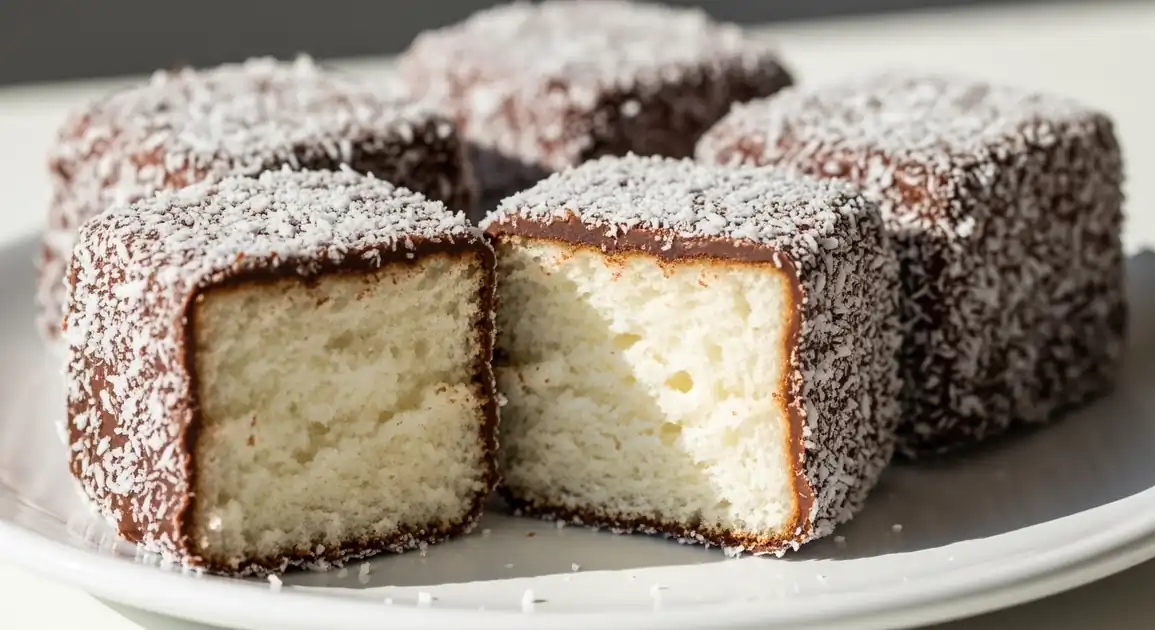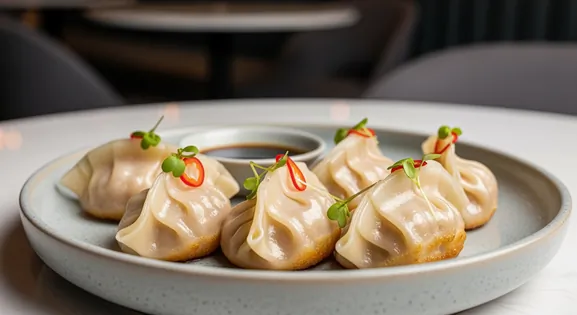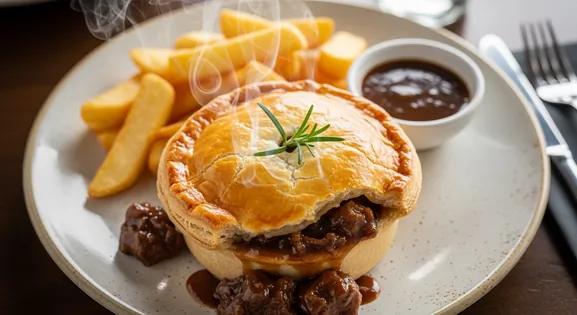Lamingtons in Australia: A Complete Food Lover's Guide
Lamingtons

What is Lamingtons?
Lamingtons are a quintessential Australian cake, beloved for their simple yet satisfying combination of textures and flavors. At its core, a lamington is a cube or square of light butter or sponge cake, dipped in a thin chocolate icing glaze, and then thoroughly coated in fine desiccated coconut. The result is a soft cake interior encased in a sweet chocolate layer with the characteristic texture of coconut.
Crafting the Perfect Dish
The process starts with baking a suitable sponge or butter cake, which needs to be firm enough to handle dipping. Once cooled, the cake is typically cut into squares or rectangles. A thin chocolate icing (usually cocoa powder, icing sugar, butter, milk/water) is prepared. Each cake square is dipped into the chocolate icing, ensuring all sides (except sometimes the base) are coated. Immediately after dipping, the chocolate-coated cake is rolled in desiccated coconut until fully covered. The lamingtons are then left to set, allowing the icing to firm up slightly. Variations involve slicing the set lamingtons and adding jam and/or cream fillings.
Key Ingredients of Lamingtons
Sponge Cake
The foundation of a lamington is a light, airy sponge or butter cake, typically made with flour, eggs, sugar, and butter or milk. It should be firm enough to hold its shape when dipped but remain moist and tender.
Quality indicator: Look for a cake that is uniformly baked, light in color, and has a fine, even crumb structure, indicating a well-aerated and properly mixed batter.
Chocolate Icing
A thin, pourable chocolate icing, often made from cocoa powder, icing sugar, butter, and a liquid like milk or water. It provides the sweet, slightly bitter chocolate layer that adheres the coconut.
Quality indicator: The icing should be smooth and consistent, not too thick or too thin, ensuring an even, non-clumpy coating that sets to a slightly firm but not brittle texture.
Desiccated Coconut
Fine, dried coconut flakes that adhere to the chocolate icing, providing the lamington's signature texture and subtle tropical flavor. It should be unsweetened or lightly sweetened.
Quality indicator: Quality desiccated coconut should be uniformly white, finely shredded, and have a fresh, mild aroma, without any yellowing or stale smell.
Perfect Partners: What to Pair
Cup of Tea
Beverage
A classic pairing, especially for afternoon tea. The warmth and slight bitterness of black tea (like English Breakfast or Earl Grey) perfectly complement the sweetness of the lamington, creating a comforting and traditional experience.
Coffee
Beverage
A strong, hot coffee, such as a flat white or cappuccino, provides a robust counterpoint to the lamington's sweetness. The coffee's acidity and depth cut through the richness of the chocolate and coconut.
From Humble Origins: A Brief History
Widely accepted as an Australian invention, the lamington is most often linked to Lord Lamington, Governor of Queensland (1896–1901). Anecdotal stories attribute its creation to his chef, Armand Galland, who perhaps needed to stretch a leftover sponge cake for unexpected guests, dipping slices in chocolate and coconut. Another story suggests it was an accident involving dropping cake into chocolate. Regardless of the exact origin, the cake quickly gained popularity and became synonymous with Australian baking, particularly for afternoon tea and fundraisers.
Local Lamingtons Variations in Australia
Jam Filled Lamington
The classic lamington sliced horizontally and filled with a layer of strawberry or raspberry jam.
Cream Filled Lamington
Sliced horizontally and filled with fresh whipped cream or mock cream.
Jam and Cream Filled Lamington
Filled with both jam and cream, a popular indulgent variation.
Raspberry Lamington
Made with a pink raspberry-flavored icing instead of chocolate.
Mini Lamingtons
Smaller, bite-sized versions of the classic cake.
Universal Quality Indicators
What to Look For
-
Fresh appearance (soft sponge, moist coconut)
Indicates the lamington hasn't been sitting out for too long. Dryness is the main quality and potential minor safety (staleness) concern for plain versions.
-
Reputable source (busy bakery, trusted cafe, known brand)
Established vendors are more likely to follow proper hygiene and storage practices.
-
Proper storage for filled versions
Cream-filled lamingtons require refrigeration to maintain quality and freshness. Observe if they are stored in a chilled display.
-
Clean display cases and handling
Ensure the cakes are protected from contamination and handled with tongs or gloves.
What to avoid
-
Dry, crumbly looking sponge
Indicates staleness, affects quality and potentially suggests poor storage.
-
Discolored or very dry coconut coating
Suggests the lamington is not fresh.
-
Cream-filled lamingtons left at room temperature
This can compromise the quality and freshness of the cream filling. Always choose those kept chilled.
-
Cracked or weeping icing
Can indicate temperature fluctuations or staleness.
Explore Lamingtons in Detail: City Guides
Discover where to find the best Lamingtons and learn local tips in these cities:
Dietary Information
Dietary Information
Important Note for Travelers: Your safety is our priority. Below are the common allergens associated with the traditional preparation of this dish. However, recipes and ingredients can vary significantly between establishments. Always confirm all ingredients directly with the food vendor before ordering, especially if you have a severe allergy.
Potential Allergens
Dietary Suitability
How to Order Lamingtons
Frequently Asked Questions about Lamingtons
What do Lamingtons taste like?
They have a soft, light sponge texture combined with the sweetness of the chocolate icing and the distinct, slightly chewy texture and mild flavor of desiccated coconut. If filled, jam adds fruity sweetness, while cream adds richness.
Are Lamingtons generally good to eat?
Yes, lamingtons from reputable bakeries, cafes, or supermarkets are generally high quality. They are baked goods. Prioritize freshness – the sponge should be soft, not dry. Be slightly more mindful of storage for cream-filled versions, ensuring they have been kept refrigerated.
Where did Lamingtons originate?
The exact origin is debated, but they are widely believed to have been created in Queensland, Australia, around the turn of the 20th century and named after Lord Lamington, the Governor of Queensland from 1896 to 1901, or his wife, Lady Lamington.
What are common Lamington variations?
Besides the classic plain version, common variations include lamingtons sliced horizontally and filled with strawberry or raspberry jam, whipped cream, or both. Sometimes different flavored icings (like raspberry or lemon) or coatings (like chocolate sprinkles) are used, though less traditional.
Are Lamingtons vegetarian?
Yes, standard lamingtons are vegetarian. Their core ingredients typically include flour, sugar, eggs, and butter or milk for the sponge cake, along with cocoa powder for the icing and desiccated coconut. These components are all plant-based or dairy/egg products, making them suitable for a vegetarian diet.
Are Lamingtons gluten-free or vegan?
Traditional lamingtons are not gluten-free (contain wheat flour) or vegan (contain eggs and dairy). However, due to their popularity, specialist bakeries or recipes now offer gluten-free and vegan versions, but these are not standard.
Expert How-To Guides about Lamingtons
How to Choose a Fresh Lamington
Tips for picking the best quality lamingtons from a bakery or cafe.
- Look for a Soft Sponge: Gently press (if appropriate/packaged) or visually assess if the sponge looks moist and soft, not dry or crumbly.
- Check the Coconut Coating: The coconut should look fresh and moist, not discolored or overly dry. It should fully coat the icing.
- Assess the Icing: The chocolate icing should look smooth and glossy, not cracked, dull, or weeping.
- Consider Filled Versions Carefully: If choosing jam or cream-filled, ensure they look freshly filled and, particularly for cream, have been stored correctly (refrigerated).
- Buy from Reputable Sources: Bakeries known for quality or busy cafes are often a better bet than mass-produced, long-shelf-life options.
Finding Authentic Lamingtons
Learn how to identify and locate establishments that are likely to offer traditional, high-quality lamingtons, ensuring an authentic culinary experience.
- Visit Local Bakeries: Independent neighborhood bakeries often take pride in classic recipes.
- Look During Australia Day: Lamingtons are particularly popular around Australia Day (January 26th), with many places showcasing them.
- Check Cafe Cake Displays: Cafes often source from good local suppliers; ask where they get their cakes.
- Consider Community Bake Sales: While variable, lamingtons made for fundraisers ('Lamington Drives') can be very traditional and homemade style.
- Avoid overly fancy interpretations if seeking the classic taste; authenticity lies in the simple sponge-chocolate-coconut combination.
Our Commitment to Quality
At Tasteplorers, our mission is to provide the most accurate and useful travel information in the world. To achieve this, all content on this site is created through our unique editorial framework. We utilize leading AI research tools, guided by our proprietary prompts, and a multi-stage validation process. This entire system is overseen by our editorial team to ensure everything we publish meets our high standards for accuracy, cultural nuance, and practical value for travelers.
Learn more about our Editorial Process and our Mission.
Explore regions
Europe
Discover Europe's diverse culinary landscape, from Mediterranean flavors to hearty Alpine fare. Learn to navigate markets, decode menus, and eat like a local.
Latin America & Caribbean
Discover the vibrant cuisines of Latin America & the Caribbean. Our expert guide covers everything from Mexican street food to Peruvian ceviche and market tips.
Oceania
Explore Oceania's diverse food scene. Learn about Polynesian earth ovens, Fijian feasts, and the vibrant café culture of Australia and New Zealand.
Southeast Asia
Explore Southeast Asia's diverse food cultures from Thailand to Vietnam. Get expert tips on navigating spice levels, choosing quality vendors, and understanding the rich traditions of the region.






